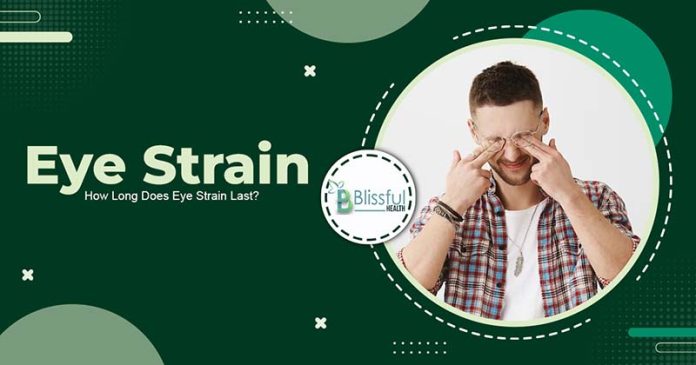In our modern world, the dominance of computers and other technological devices has led to increasing concerns about eye health. Many of us spend hours glued to computer screens during work, constantly check our phones, or drive long hours into the night, all of which can contribute to eye strain, a common yet uncomfortable issue.
At Blissfulhealth, we offer effective strategies to reduce and prevent eye strain, thereby reducing the risk of developing more serious health problems.
Defining Eye Strain: What You Need to Know
Eye strain is a typical condition that arises when your eyes become fatigued from prolonged use, like driving for extended periods or gazing at computer screens and various digital devices.
While eye strain is usually not severe and often improves with rest or by taking steps to reduce discomfort, there are times when symptoms of eye strain could indicate a more serious underlying eye condition that needs attention.

The Primary Causes Behind Eye Strain
One of the primary culprits behind eye strain is the prolonged use of digital screens, a habit that has become pervasive in today’s society. According to the Vision Council, a staggering 87 percent of individuals in the United States spend more than two hours per day on one or more digital devices. What’s more concerning is that this trend isn’t limited to adults alone. The same report reveals that 76.5 percent of American children are also exposed to screens for more than two hours daily, putting them at risk of experiencing eye strain and related conditions.
In addition to excessive screen time, other common triggers for eye strain include:
- Engaging in a single task for an extended period, such as driving or reading.
- Being in an environment with inadequate lighting, whether it’s too dim or overly bright.
- Feeling stressed or fatigued, which can exacerbate eye discomfort.
- Dealing with vision problems or issues like dry eyes.
Furthermore, specific to digital eye strain, contributing factors may include:
- Maintaining poor posture while using digital devices.
- Decreased frequency of blinking, typically observed during screen use.
- Holding a digital device at an improper distance from the eyes.
- Prolonged exposure to blue light emitted by digital screens.
- Viewing screens with improperly adjusted lighting settings.
Typical Symptoms Associated with Eye Strain
Eye strain symptoms can affect more than just your eyes; they can also manifest in various parts of your body, reflecting the interconnected nature of our visual and physical health.
Eye-related symptoms of eye strain are diverse and may include several noticeable signs, such as:
- Watery eyes
- Blurred vision
- Dry eyes
- Itching eyes
- Sensitivity to light
- Burning sensation in the eyes
- Difficulty keeping your eyes open
Other symptoms associated with eye strain may affect different parts of your body, such as:
- Headaches
- Neck pain
- Shoulder pain
- Back pain
- Difficulty concentrating
How Long Does Eye Strain Last: Insights and Facts
There’s a lack of detailed studies on the exact duration of eye strain. However, insights from the American Optometric Association suggest that the duration of your discomfort may vary depending on several factors.
Factors influencing the duration of eye strain include:
- Screen Time: The amount of time spent looking at screens plays a significant role. Prolonged screen use can exacerbate symptoms of eye strain.

- Vision Conditions: Individuals who are nearsighted or have astigmatism may experience prolonged or more severe symptoms.
- Untreated Vision Conditions: If you have an untreated vision condition, it can exacerbate symptoms of eye strain, potentially prolonging discomfort.
It’s essential to address any underlying vision conditions promptly to alleviate symptoms and prevent further discomfort.
Relationship Between Eye Diseases and Eye Strain
Regular and excessive eye strain does not directly cause major eye diseases, which are typically related to aging, genetics, and health conditions like diabetes and hypertension. However, chronic eye strain may exacerbate symptoms in those already suffering from eye conditions, adding to their discomfort.
Symptom Overlap: Some symptoms associated with eye strain, such as blurred vision and headaches, can also be indicators of more serious eye conditions. This overlap occasionally leads to delayed diagnosis of eye diseases, as individuals may attribute their symptoms to eye strain rather than seeking prompt medical attention.
Management and Prevention: Effectively managing eye strain through adopting healthy screen habits, ensuring proper lighting, and taking regular breaks can enhance overall eye comfort and promote better eye health. For individuals with pre-existing eye diseases, managing eye strain is a crucial component of a comprehensive strategy aimed at maintaining optimal vision health.
In conclusion, while eye strain is typically a transient and reversible condition, individuals experiencing persistent or severe eye discomfort should consult healthcare professionals to rule out or address any underlying eye diseases.
Experiencing Eye Strain: What It Feels Like
Patients encountering eye strain may express a variety of sensations and reactions. These encompass:
Dry Eyes: Patients often describe this as a scratchy or gritty feeling, as if something is in their eyes. It can result from not blinking enough, especially while focused on screens, causing the eyes to feel uncomfortably dry.
Headaches: These can be frequent and range from dull to throbbing pain, often exacerbated by prolonged eye strain. The headaches may occur around the forehead or temples and can be persistent or come and go.
Blurred Vision: This involves a noticeable difficulty in seeing details clearly, which can make it hard to focus on text or objects. Patients might report that their normal vision suddenly becomes fuzzy, impacting their ability to perform tasks.
Double Vision: This symptom is described as seeing two images of a single object, which can be disorienting and impair one’s ability to navigate their surroundings effectively.
Sensitivity to Light: Patients might experience an increased discomfort or even pain when exposed to bright lights. This can make environments like brightly lit offices or sunny outdoor spaces particularly challenging.
Muscle Tension: Eye strain can also lead to physical discomfort in other parts of the body. Patients may feel tension or soreness in the neck, shoulders, or back. This often results from maintaining a strained posture for long periods while using devices or reading.
Eye Fatigue: This is characterized by a heavy, tired feeling in the eyes, often accompanied by an irresistible urge to close them for relief. Patients describe this as feeling as if their eyelids are weighed down, making it difficult to keep their eyes open.
Individuals may describe eye strain differently, ranging from feelings of tiredness or watery eyes to facial muscle fatigue from squinting or headaches associated with eye strain.
Proactive Measures to Guard Against Eye Strain
Implement these strategies to alleviate or prevent eye strain:
- Stay Hydrated: Ensure adequate hydration by drinking plenty of water throughout the day. Proper hydration helps maintain moisture levels in your eyes, reducing dryness and discomfort associated with prolonged screen use. It also supports overall eye health and well-being.
- Take Breaks: When engaging in activities such as reading or close work, take regular breaks to rest your eyes. Look away from the page, digital screen, or task periodically to give your eyes a chance to relax.

- Limit Screen Time: Especially for children, it’s crucial to limit screen time to prevent eye strain. Extended screen use without breaks can lead to discomfort and fatigue. Encourage children to take regular breaks and rest their eyes.
- Use Artificial Tears: Nonprescription artificial tears can help prevent and relieve dry eyes. Even when your eyes feel fine, using artificial tears helps keep them lubricated and prevents symptoms from recurring. Consult with your eye specialist to determine the most suitable eye drops for your needs.

- Improve Air Quality: Enhance the air quality in your environment to prevent dry eyes. Consider using a humidifier to add moisture to the air, adjust the thermostat to reduce airflow, and avoid exposure to smoke. If you smoke, quitting can significantly benefit your eye health. Additionally, repositioning your chair to minimize exposure to dry, moving air can help reduce eye and facial discomfort.
- Choose Proper Eyewear: If you require glasses or contacts and spend a significant amount of time working at a computer, consider investing in eyewear specifically designed for computer use. Discuss with your optometrist about lens coatings and tints that can provide additional protection and comfort.
By incorporating these proactive measures into your daily routine, you can effectively mitigate eye strain and promote long-term eye health.
Effective Long-term Strategies for Reducing Eye Strain
To effectively reduce eye strain over the long term, consider implementing the following lifestyle adjustments and proactive measures:
Regular Eye Exams: Ensure your eye health and vision prescription are up-to-date by scheduling regular eye exams. Discuss with your eye doctor strategies to minimize eye strain at work and reduce screen time.
Proper Lighting: Optimize your workspace lighting to reduce eye strain. Adjust the brightness of your monitor and ambient lighting to comfortable levels. Avoid harsh glare on your screen by using anti-glare monitor screens or lenses with anti-reflective coatings.
Follow the 20-20-20 Rule: Give your eyes periodic breaks to alleviate strain from prolonged screen use. Adhere to the 20-20-20 rule: Every 20 minutes, take a 20-second break to focus on an object approximately 20 feet away. This practice helps reduce eye fatigue and strain.
Maintain a Clean Screen: Keep your device screen free of smudges and fingerprints to enhance clarity and reduce glare. Consider using blue-light-blocking screen protectors to minimize exposure to blue light emitted by digital devices.
Set Screens at Proper Distances: Position your screen at a comfortable distance, slightly below eye level, and approximately 20 to 28 inches away from your eyes. Ensure proper screen placement to prevent neck strain and adjust reference materials accordingly.
Create a Well-Lit Workspace: Establish a well-lit workspace with balanced lighting to minimize shadows and glare on your screen. Use window shades and blinds to control natural light and maintain a dim, evenly lit environment conducive to reduced eye strain.
Seek Professional Advice: If you experience persistent eye strain despite making adjustments, consult an ophthalmologist. Describe your symptoms accurately to receive appropriate guidance and potential prescriptions for computer glasses or other aids tailored to your needs.
By incorporating these effective long-term strategies into your daily routine, you can significantly alleviate eye strain and promote overall eye health and comfort.
The Role of Regular Eye Exams in Eye Health
Regular eye exams are essential for maintaining eye health, especially with the widespread use of screens in our daily lives. Eye care professionals conduct these exams to detect early signs of screen-related issues like digital eye strain and dry eye syndrome.
In addition to checking vision, comprehensive eye exams can reveal early signs of eye health problems such as glaucoma, cataracts, and age-related macular degeneration. Since excessive screen use can worsen these conditions, regular eye exams are crucial for keeping your eyes healthy.
Conclusion
In conclusion, prioritizing regular eye exams is essential for preserving eye health, especially in the digital age dominated by screen time. These exams help detect issues like digital eye strain and reveal early signs of serious eye conditions.
You might wonder, How long does eye strain last? The duration can vary, but regular check-ups can catch problems before they worsen or become persistent. We invite you to share your own experiences with eye health and encourage you to explore more insightful blogs on BlissfulHealth for further guidance and information on maintaining optimal eye health. Remember, your eyesight is precious—take proactive steps to care for it.


